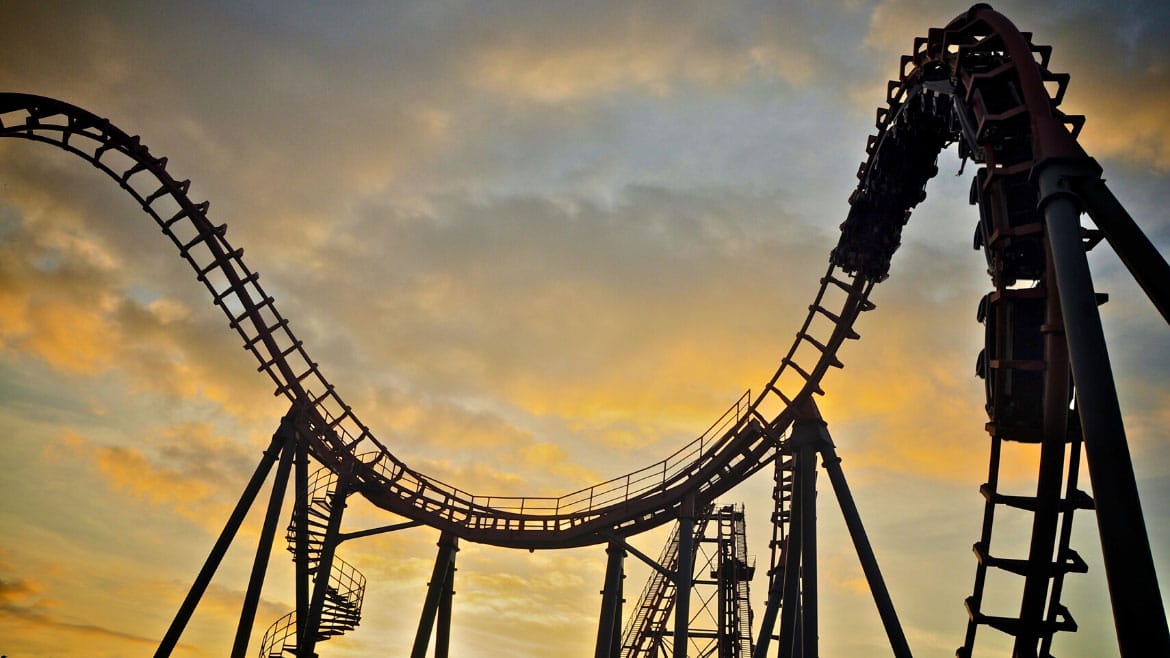Hitching a Ride on the Stock Market Rollercoaster

Think of the stock market as the premier rollercoaster at the greatest theme park in the world. You buy a ticket, buckle up, and away you go. You expect there to be slow parts and steep climbs, followed by thrilling drops, swooshes, and flips. Some rollercoasters even stop mid-ride and go backward! If you’re like me, you like the thrill of “taking a chance” as long as you know the ride has a very high probability of ending safely at the finish line. Imagine getting on the “Stock Market Rocket” at your favorite amusement park and pretend that the ride started in 2016, I’ll do the play-by-play:
Leaving the gate: Quick 18-foot drop! Yikes
Around the first bend: Slow long 24-foot incline and a FLASH 10-foot drop! Just enough to make your heart flutter like airplane turbulence.

The top of the climb: Woosh! 30-foot vertical drop, spinning and jerking you up and down 20-feet at a time over and over and over again.
Around the third bend: Everything smooths out, and you begin a modest-looking 36-foot incline. It’s slow, and it gives your heart rate a chance to come down.
Out of nowhere: A nearly 60-foot drop spinning you backward, unable to see where you’re going, you can only see the sky as it feels like a total loss of control. You must be near the ground; it feels like you’ve been falling forever.
Back up: You’re jerked so aggressively, you are nearly bent in half, and back upwards you go, gawking at the earth still 44 feet below you as you climb an astonishing 116 feet in the air. Things look tiny from so high up. You’re spun around at the very apex of the climb, viewing the countryside underneath you, feeling as though you could glide away.
Around the next bend: 3-times as quickly as you climbed to the apex, you plummet back down 116 feet, only this time you see what’s ahead of you. The ground, and it’s coming so fast.
A reprieve: A 24-foot bounce, like a rubber ball, sends you upside down 70 feet above where you started, and you close your wind-burnt eyes. Time is frozen, seconds seem to take hours, and you think to yourself: “I’m upside down, my stomachs churning, I’m out of tears and my eyes are dry, everyone is screaming. I know this ride will end with me safely at the finish line, I just have to wait long-enough to get there. I probably shouldn’t unbuckle and jump for safety from 70 feet up.
This is a parody based on the S&P 500 performance from January 1, 2016, through March 27, 2020, which includes a presidential election, tax overhaul, trade-war, presidential impeachment proceeding, record unemployment, and now the Coronavirus, a recession, 0% interest rates, the CARES Act, and the soon to come recession recovery (all recessions have a recovery) and another presidential election.
The point to this parody is that if you knowingly purchased the ticket, got on the ride, and buckled in, you shouldn’t jump off mid-ride. What you should do is decide if you prefer to watch what’s happening or if it’s better for you to close your eyes.
In relation to the markets, closing your eyes is perfectly acceptable, assuming that you had a solid plan before the market dropped and, preferably, that you have professionals in place to help make sure you stay on the track while you’re not looking. But, if you are willing to look, you’ll have a much more exciting ride. You’ll get your money’s worth. You’ll see all kinds of opportunities to sell and diversify old investments, at a lower tax hit. You’ll be inundated with opportunities to buy companies that haven’t been this unbelievably cheap in many years. You’ll see ways to reduce your lifetime income taxes dramatically by taking advantage of ROTH conversions and employing portfolio strategies that put your most growth-oriented investments under a lifetime of tax-free growth. Take advantage of your current situation; this type of market event doesn’t happen very often.
The “bad market” is just the unavoidable part of the ride that makes the “good market” great.
This article is for educational purposes only and should not be considered investment advice. Past performance is no indicator of future success. Please consult a financial professional before taking any action.
If you need help making sure your portfolio/investments are prepared for the next coaster turn, please contact our team, and one of our financial planners might be able to help you. Your initial meeting is free of cost and confidential — Call 607-217-5091 to schedule.
S.E.E.D. Planning Group LLC (S.E.E.D.)is a Registered Investment Advisor (RIA) with the Securities Exchange Commission. S.E.E.D.’s team provides investment fiduciary and fee-only financial planning services to clients. Our fees are disclosed, easy to understand, and not predicated on product sales.


